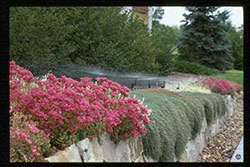Water is the key to life on earth, yet less than three percent of it is available to humans, so make every drop count. Efficient irrigation is important because more than 50 percent of residential water is used for landscaping. In addition, most plant diseases and deaths are caused by over watering.

One way of conserving water is to reduce the area of a landscape that is irrigated. Another way to reduce the amount of water used is to change how a lawn and garden is watered. Water landscapes manually with hoses and sprinklers, or with more sophisticated methods like drip irrigation or in-ground systems that use buried pipe and nozzles.
Water use can be reduced by at least 30 percent with a few simple steps. Make certain that water falls only on landscaped areas, water in the cool of the morning or evening to reduce evaporation, and avoid watering during rainstorms or in the wind. Adjust nozzles or water pressure to produce droplets of water rather than a foggy mist. Change watering times at least once each month to meet the water needs of the landscape. Group plants with similar water needs. Rainfall can also be directed from gutters and down spouts onto a landscape.
For more information, see the following Colorado State University Extension fact sheet(s).
- Xeriscaping: Creative Landscaping
- Drip Irrigation for Home gardens
- Microirrigation for Orchard and Row Crops



